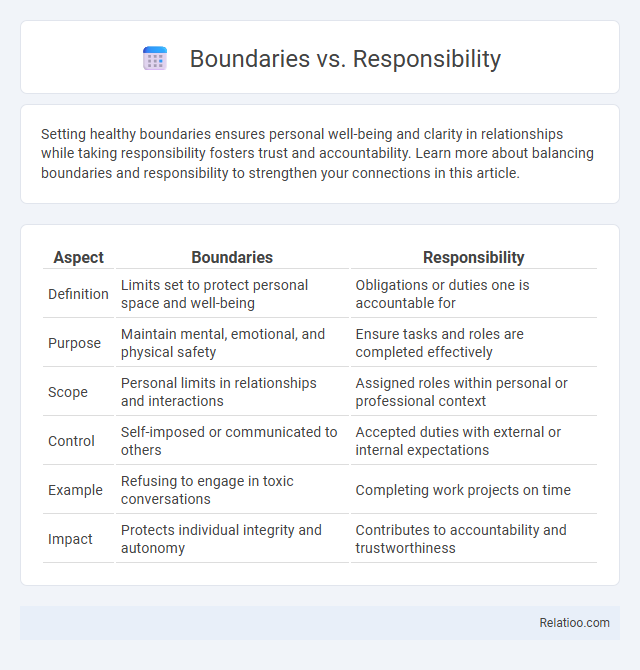Setting healthy boundaries ensures personal well-being and clarity in relationships while taking responsibility fosters trust and accountability. Learn more about balancing boundaries and responsibility to strengthen your connections in this article.
Table of Comparison
| Aspect | Boundaries | Responsibility |
|---|---|---|
| Definition | Limits set to protect personal space and well-being | Obligations or duties one is accountable for |
| Purpose | Maintain mental, emotional, and physical safety | Ensure tasks and roles are completed effectively |
| Scope | Personal limits in relationships and interactions | Assigned roles within personal or professional context |
| Control | Self-imposed or communicated to others | Accepted duties with external or internal expectations |
| Example | Refusing to engage in toxic conversations | Completing work projects on time |
| Impact | Protects individual integrity and autonomy | Contributes to accountability and trustworthiness |
Defining Boundaries and Responsibility
Defining boundaries involves clearly identifying your personal limits and areas where you hold control, ensuring you protect your emotional and physical well-being. Responsibility refers to the duties and tasks you are accountable for, influencing how you manage your time, decisions, and actions within those boundaries. Understanding the distinction helps you prioritize your commitments without compromising your values or overextending yourself.
The Importance of Setting Healthy Boundaries
Setting healthy boundaries is crucial for maintaining personal well-being and preventing burnout by clearly defining what is acceptable in relationships and work. Boundaries protect an individual's responsibility to themselves, ensuring they do not overextend or assume obligations that compromise their mental health. Establishing limits fosters respect from others, allowing for balanced interactions and sustained personal accountability.
Understanding Personal vs Shared Responsibility
Personal boundaries help define where your responsibility ends and another's begins, ensuring clear limits in relationships. Shared responsibility requires collaboration and mutual accountability, where obligations are divided based on roles and agreements. Understanding these distinctions prevents misunderstandings and promotes healthy interactions by balancing what you manage independently versus jointly.
Recognizing Boundary Violations
Recognizing boundary violations requires understanding how personal limits intersect with responsibility and obligation in relationships. Boundaries protect individual autonomy while responsibilities involve ethical or social duties, and obligations imply mandatory actions, making it essential to differentiate when an action oversteps respect for personal space versus fulfilling a role. Identifying boundary violations involves observing behaviors that disregard consent, impose undue control, or neglect mutual respect, which can undermine trust and disrupt healthy interactions.
The Role of Communication in Maintaining Boundaries
Effective communication plays a crucial role in maintaining clear boundaries, ensuring your personal space and limits are respected without confusion. By articulating your expectations and responsibilities clearly, you prevent misunderstandings and reduce conflicts in relationships. Consistent dialogue helps differentiate between what you are responsible for and what you are obligated to do, fostering mutual respect and emotional well-being.
Balancing Accountability and Autonomy
Balancing accountability and autonomy requires understanding the distinctions between boundaries, responsibility, and obligation in personal and professional contexts. Clear boundaries define the limits of individual roles, enabling responsibility to be appropriately assigned without overstepping, while obligations represent formal duties that must be fulfilled regardless of autonomy. Effective balance promotes empowered decision-making while ensuring accountability through agreed-upon expectations and mutual respect.
Boundaries in Personal Relationships
Setting clear boundaries in personal relationships establishes limits that protect your emotional well-being and define acceptable behavior from others. Boundaries differentiate your responsibilities from those of others, preventing unnecessary obligation overload and fostering mutual respect. Recognizing and maintaining these boundaries helps you avoid feeling accountable for others' actions while promoting healthy, balanced connections.
Boundaries and Responsibility in the Workplace
Boundaries in the workplace define clear limits on personal and professional interactions, ensuring respect and preventing burnout, whereas responsibility refers to the specific duties and tasks an employee is expected to fulfill within their role. Establishing and maintaining healthy boundaries enhances productivity and job satisfaction by preventing overreach and clarifying accountability. Effective management of boundaries and responsibility fosters a respectful work environment and promotes efficient task completion.
Overcoming Guilt When Enforcing Boundaries
Enforcing boundaries is essential for personal well-being and mental health, distinguishing between what one is responsible for and what one is obligated to do reduces unnecessary guilt. Understanding that setting limits protects self-respect without neglecting commitments helps overcome feelings of guilt associated with boundary enforcement. Emphasizing self-awareness and clear communication reinforces healthy boundaries while honoring responsibilities, preventing the blurring of obligations that often fuels guilt.
Strategies for Cultivating Responsible Boundaries
Cultivating responsible boundaries involves clearly defining personal limits while acknowledging obligations to others, ensuring respectful interactions and accountability. Strategies include consistent self-reflection to identify core values, assertive communication to express needs without infringing on others' rights, and setting consequences to uphold those limits. Balancing boundaries with responsibilities fosters healthier relationships and prevents burnout by maintaining mutual respect and clarity.

Infographic: Boundaries vs Responsibility
 relatioo.com
relatioo.com